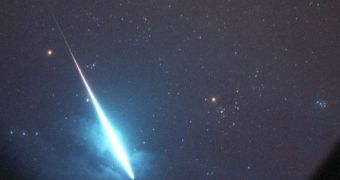Add water, a mix of complex chemical substance, sunlight and you might eventually end up creating life. And don't forget about adding meteorites! Only if things were so easy. Previously, scientists believed that the primordial soup, from which the first living being emerged, was formed of ingredients found only here on Earth. Now, researchers from the Carnegie Institution argue that it might have been more than that, as they have recently discovered large concentrations of amino acids - one of the key substances for life - in two meteorites.
This is usually nothing out of the ordinary, meteorites have been proven to contain some amounts of amino acids in their structure, albeit these two particular space rocks contain ten times the concentration of ordinary meteorites, meaning that at one point in time the solar system might have been filled with organic substances essential to life. Eventually, some of these organic rich meteorites fell to Earth contributing to the appearance of life.
Amino acids are basically the 'skeleton' of proteins which compose nearly all the structures and control the chemical reaction taking place within a living cell. No wonder that the creation of proteins is synonymous with the appearance of life on Earth. Amino acids are also formed on Earth, however, scientists at Carmegie Geophyiscal Laboratory, Department of Terrestrial Magnetism and Imperial College London, believe that the appearance of life on Earth could have only been catalyzed by the amino acids coming from meteorites.
Both of the space rocks were discovered in Antarctica, in 1992 and 1995, and are now in the custody of NASA's Johnson Space Center. It should probably be mentioned that Antarctica is the world's best hunting ground for meteorite fragments, mostly due to the fact that they are easier to find in ice. During the study, three meteorites were sampled for the presence of primitive organic substances. This particular type of meteorites are part of the CR chondrites class being some of the oldest bodies in the solar system.
While some of these bodies eventually grew into planets, others were shattered by collisions with other space rocks such as asteroid or other meteorites, and sent into an orbit around the Sun. Chemical analysis showed that while one of the three contained a concentration of only 15 part per million amino acids, the other two reached levels as high as 180 and 249 parts per million. Contamination with organic substances from Earth was ruled out, as carbon dating showed that the two meteorites had organic molecules of extra-terrestrial origin.
Department of Terrestrial Magnetism researcher Conel Alexander says that: "The amino acids probably formed within the parent body before it broke up." Other complex chemical substances, such as ammonia, can be created in solar nebula and interstellar space, which when combined with water form amino acids. Some fragments of the parent body fell to Earth and other rocky planets, while others were incorporated into comets or asteroids, which may have or may have not impacted our planet in the past.

 14 DAY TRIAL //
14 DAY TRIAL //